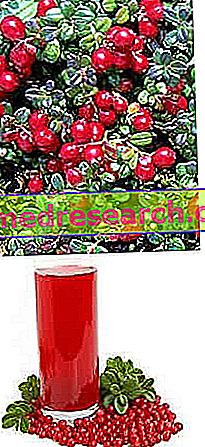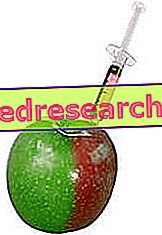What is cranberry juice?
Cranberry juice means the drink obtained from the processing of Cranberry, otherwise known as marsh cranberry; the latter is nothing but the fruit of Vaccinium vitis-idaea, a perennial shrub belonging to the Ericaceae family , spontaneous in North America (from the Carolina to Canada) and cultivated extensively throughout the USA.

Production
How is cranberry juice produced?
The procedure useful for the production of cranberry juice is very simple; after getting 100g of fresh (or frozen) blueberries, half a lemon and a tablespoon of honey ... wash the blueberries, blend them with QB water, add the lemon juice and sweeten with honey.
Obviously, the one just described is the procedure useful for the production of cranberry juice to be consumed instantly; there are also CONCENTRATED cranberry juice forms that have been partially dehydrated. Before consumption, this product needs to be rehydrated with water or alternatively with apple juice.
Nutritional values
NB. The values shown below refer to 100g of cranberry, which is the equivalent of a portion of cranberry juice. These values should then be added to those in vitamins of lemon juice (mainly ascorbic acid) and honey carbohydrates (mainly simple).
| Energy value | 46kcal |
| Protein | 0, 39g |
| Carbohydrates | 12, 2g |
| Simple | 4, 04g |
| Grassi | 0, 13g |
| Saturated | 0, 011g |
| Monounsaturated | 0, 018g |
| polyunsaturated | 0, 055g |
| Dietary fiber | 4, 6g |
Vitamins | |
| Mostly... | |
| Thiamine | 0, 012mg |
| Riboflavin | 0, 02mg |
| Niacin | 0, 101mg |
| Vit. C | 13, 3mg |
Minerals | |
Mostly... | |
| Potassium | 85mg |
Active ingredients of cranberry
The active and therapeutic ingredient of cranberry juice is basically made up of antioxidants; these include: flavonoids, pro-anthocyanins of type A, catechins, triterpenoids, tannins, ascorbic acid (vit. C), beta-hydroxybutyric acid, citric acid, malic acid, glucuronic acid, quinic acid, etc.
To tell the truth, the scientific evidence obtained on the antioxidant potential of the cranberry refers above all to the action of the pro-anthocyanins of type A, which also represent the qualitative parameter of reference. In the CONCENTRATED cranberry juice should be present at least 1.2-1.4% of pro-anthocyanins type A, but on the market it is also possible to find cranberry juice at 15% of polyphenols (antioxidant pool) .
It works?
Does cranberry juice work?
Cranberry juice is a product used mainly as an antioxidant supplement or as an urinary antiseptic pseudo-drug, which slows down or prevents the development of bacteria within the bladder or urinary tract (prevention of cystitis and an adjunct to drug treatment).
Antiseptic function of cranberry juice
cranberry juice has two properties useful for reducing microbial growth in the urinary tract:
- Acidifies the urine significantly limiting the multiplication potential of Escherichia coli, a bacterial strain potentially responsible for these diseases
- It inhibits bacterial adhesion to the suerficial (epithelial) cells of the urinary tract
Antioxidant function of cranberry juice
As anticipated, cranberry juice contains a pool of antioxidants very useful in reducing free radicals potentially harmful to lipids and cellular proteins. Some experimental studies have shown a reduction in the growth of tumor cells in eight different cytotypes, a characteristic that allows DEDURT a POTENTIAL preventive function of cranberry juice towards malignancies of various kinds.
NB . Cranberry juice has NO contraindications as it does not have the antioxidants it contains (even at pharmacological doses).
Watch the video
X Watch the video on youtubeTherapy and method of use
The use of cranberry juice could probably be seen in the prophylaxis of urinary infections and in the prevention of complications attributable to free radicals. However, some in-depth analyzes carried out on a North Carolina pediatric research sample showed that 29% of the parents of hospitalized children regularly administered cranberry juice to their children, but of these, 65% were still subject to recurrent kidney infections. This condition could probably be attributed to a difference in the pathogen responsible, as cranberry juice seems to manifest its antiseptic action especially towards some strains of Escherichia coli (as for mannose, the same effect has not been evidenced towards other bacterial strains) .
Using portions of 500-750ml / day, some clinical studies gave conflicting results; the IN VIVO (the most reliable) insights that used 750ml / day of cranberry juice per day did NOT describe a marked improvement in antioxidant plasma activity and oxidative stress biomarkers. On the contrary, studies in VITRO (less reliable) showed an increase in plasma antioxidant potential and a decrease in oxidized LDL.
The same applies to the evaluation of antiseptic potential; while the aforementioned North Carolina pediatric research does not seem to investigate miraculous properties attributable to cranberry juice, many other investigations have shown a significant decrease in bacteriuria (bacteria in the urine), of pyuria (pus in the urine) and therefore of recurrent urinary infections especially in geriatric patients.
Bibliography:
- Pediatric phytotherapy - V. Murgia, . Ventrigaglia - Elsevier Masson - pag. 164: 168



